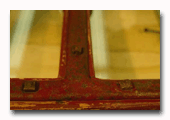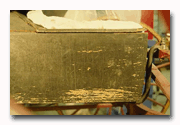
|
Scientific Instruments Selling Objects |
|
Sue Warren, Conservator, Canada Science and Technology Museum Paper presented at the IIC-CG Conference, Halifax 1993.
Horse–drawn vehicles are among the most complex and challenging objects conservators face in preservation work. Conservation requires familiarity with the materials and with specific problems associated with these beautiful composite artifacts. Many vehicles found today have been repainted and re-trimmed so that they can be used, a fate shared by many types of transportation artifacts. From a private collector's point of view this is necessary maintenance, but as a museum primarily interested in the original materials and technologies, we count ourselves very lucky when we find a vehicle in sufficiently complete and original condition that conservation treatments will render it acceptable for exhibit. The subject of a recent conservation project was an early 20th–century McLaughlin Piano Box buggy, which had been previously displayed in the Museum. Because of its significance to the history of road transportation in Canada, this buggy was chosen for conservation treatment so that it could again be featured on exhibit. Robert McLaughlin founded the McLaughlin Carriage Works in 1869. By 1900 he employed over 600 workmen and had an annual output of 25 000 vehicles. The advent of the automobile at the turn of the century led the McLaughlins to form a motor car company in 1907 and to begin producing the McLaughlin Buick. By 1915, sales of carriages were in such decline, that the carriage company was sold to a competitor. After that date production of McLaughlin carriages was discontinued. This McLaughlin buggy dates from the turn of the century, and the presence of metal rims on the wheels indicates it was probably built for use on rural roads rather than paved on city roads. It was our most complete and structurally stable example of this once common mode of travel. In appearance, its painted finish was dull black, with no distinguishing features. All nickel–plated seat and dash rails were brown with spots of corrosion erupting through the remaining plating, and painted ironwork was actively corroding. All elements of the vehicle were treated separately, according to material: the wheels were removed and axles cleaned and regreased; all metals were stabilized; where necessary the paintwork was consolidated and fragile textiles were reinforced. The following is a brief summary of the treatments carried out on the buggy. Gear
Removing old axle grease has to rank as one of the worst aspects of carriage conservation, but it can also be one of the most enlightening. Grease often does more to preserve original paint colour than even the most well-intentioned conservator can hope to do. Carefully removing deposits from the axles can reveal original colours, and often striping, not visible elsewhere. A major hazard, however, is that sometimes the grease can soften the underlying paint and make it more easily soluble in the same solvents proven safe elsewhere on the vehicle. In the case of the McLaughlin buggy, the treatment revealed a brilliance of colour on the axles and wheel hubs that had been lost on the exposed paint work. Nothing can be done to bring back lost colour; however, the cleaned patches gave us an indication of the vivid colour scheme originally used.
All the painted ironwork on the gear and wheels was in relatively good condition. The major problem was the amount of rust staining on the paintwork around corrosion. To address this, a reducing agent was used which converts oxidation products to their metallic form so that they can be washed away. Sodium hydrosulfite, dissolved in water and warmed during use, was wiped or swabbed onto the area and left to sit for a few minutes. The area was then thoroughly rinsed and the treatment repeated until the desired effect was achieved. This does not work on all surfaces; the solution may dissolve some paints, so testing on a small hidden area is always required. In the case of the McLaughlin, the treatment was very successful and removed virtually all evidence of rust staining.
Exposed metal surfaces were then stabilized with tannic acid. This is a chelating agent that chemically bonds with iron oxides to form a stable compound. When fully reacted, the resulting finish is black. The metals were then coated with an acrylic resin to protect both the paint and the now stabilized metal. The two preferred resins are Acryloid B-72 for wood and paint and Acryloid B-48 for metals. 10 per cent solution in toluene is ideal for consolidation and protective coatings. The wood on the wheels was sound but had very active loss of paint. This was cleaned and then consolidated with B-72. In most instances the resin restores the original varnish qualities and saturates paint colours. In cases such as the wheels, where there is substantial exposed bare wood, the gloss qualities can be distracting and the resin may be mixed with fumed silica powder, to give a matte surface. Paintwork The next stage of treatment involved removing the hood for better access to the body panels and to the hood itself. The seat back, which had been protected by the rear curtain, appeared to be covered in a very soft dirty varnish layer. A quick wipe with ethanol and mineral spirits removed enough of the surface layer to reveal two bright yellow fine stripes around the perimeter. The varnish was subsequently removed using the same mixture of solvent, applied with cotton pads.
It was possible now to discern other ghostly images in the paint layer, made all the more visible by shining a black light (ultraviolet) on the paintwork. At first, they appeared to be remnants of decals and not likely to be improved much by varnish removal. In addition, the varnish on the exterior panels was considerably more difficult to remove and the original striping and decoration more degraded.
The results of the treatment are stunning when compared with the dull black finish originally visible. The handpainted flowers and leaf motifs are so finely executed that they are absolutely unique. These areas were consolidated with B-72 resin for protection and to saturate the colour. Metals All iron hardware from the body was removed, where possible, for mechanical cleaning. Most of these elements were cleaned with air abrasion and walnut shell dust. Walnut shell is obtainable in various grit sizes; combined with varying the pressure of the air abrasion unit, it allows for an almost infinite range of care when removing corrosion. A fine dust at 25 psi can remove corrosion and the oxidation layer from secure paint without actually removing any of the original paint layer. Tannic acid treatment and consolidation with B-48 followed all cleaning procedures. Chromed brightwork was cleaned mechanically to remove polish residues; in areas of active corrosion, alkaline glycerol was used. Alkaline glycerol is a chelating agent that removes copper corrosion products. It is effective on the discolouration of nickel plate due to corrosion of underlying copper alloys. This treatment is preferable to polishing, which actually removes plating material and which can dislodge loose plate. Simply polishing the surface also does nothing to address the reason for the discolouration or loss, namely corrosion of the base metal. The chelating agent must be thoroughly rinsed to ensure no further reactions and then consolidated to prevent further contamination from handling or exposure. A further treatment for severely corroded copper alloys is painting on a 1 per cent solution of Benzotriazole (BTA) in alcohol. This acts on copper much like tannic acid does on iron corrosion products, forming stable compounds on the surface. BTA has been proven to be highly carcinogenic, so this treatment should be undertaken only with proper equipment and facilities. Trim
The leather seats of the buggy were mechanically cleaned of all waxy deposits and previously applied dressings, and then washed with Lexol leather cleaner. A final treatment with Lexol NF was then carried out; this required several repetitions due to the desiccation of the leather. Lexol NF is a neatsfoot oil and lanolin mixture which is commercially available and is pH balanced to remain stable over time. It still requires regular maintenance, however. Leather is one of the most problemmatic materials conservators must deal with, since there is little that can be done to restore the strength of degraded leather. Lubricating it can give the appearance of stability, but it must be remembered that lubricating a weak fibre network does nothing to add strength. Small tears in the cushion fall were repaired by stitching because adhesive repairs where the area is under stress are seldom effective in the long run. In this case, a small piece of reinforcing fabric was inserted between layers into the torn area, and stitched using original holes. Hood
The oilcloth top was cleaned with a rag slightly dampened with distilled water. Bloom appears very easily on this material and any introduction of solvent, including waxes, is disfiguring. Oil does saturate the colour of this material, but it is essential to use an oil that does not polymerize to become brittle. Unfortunately, this leaves you with a finish that can remain sticky and attract dust.
The introduction of oil was not justified in the case of the McLaughlin, since the oilcloth hood was not a prominent feature; certainly the disadvantage of dust accumulation was a factor. Flaking edges of oilcloth were consolidated with a mix of PVA (white glue) and acrylic paint. This remains flexible to a certain extent, and secures the loose edges, which might otherwise flake off. This treatment holds up very well even with moderate flexing.
The hood lining presented numerous problems; it had been previously inhabited by mice and had been repaired on many occasions. Complete disassembly of the roof would have entailed removing the oilcloth and flexing it more than was advisable. Therefore, the tacks from around the inside top edge were removed and the two glued side seams released. This facilitated opening up the lining to the back edge.
The fabric was cleaned using a crudely constructed wet-vacuum table which was nothing more than a watertight plexiglass box with a screen on top. This was attached to a wet vacuum to draw out nearly all the liquid introduced. Sponging with first soapy and then clean water removed almost all of the dirt and staining. The cloth was then backed with new material and the roof reassembled. Our newly rediscovered McLaughlin buggy now stands on display as an example of early Canadian road transportation technology. It is doubtful that any but the most discerning visitor will notice the beautiful handpainted details, but the vehicle has been stabilized and will be preserved for future generations to admire the artistry of carriage makers. Questions regarding McLaughlin Piano Box Buggy should be sent to: SWarren@technomuses.ca |

|
Technology Museum Comments to: webmaster@technomuses.ca |












